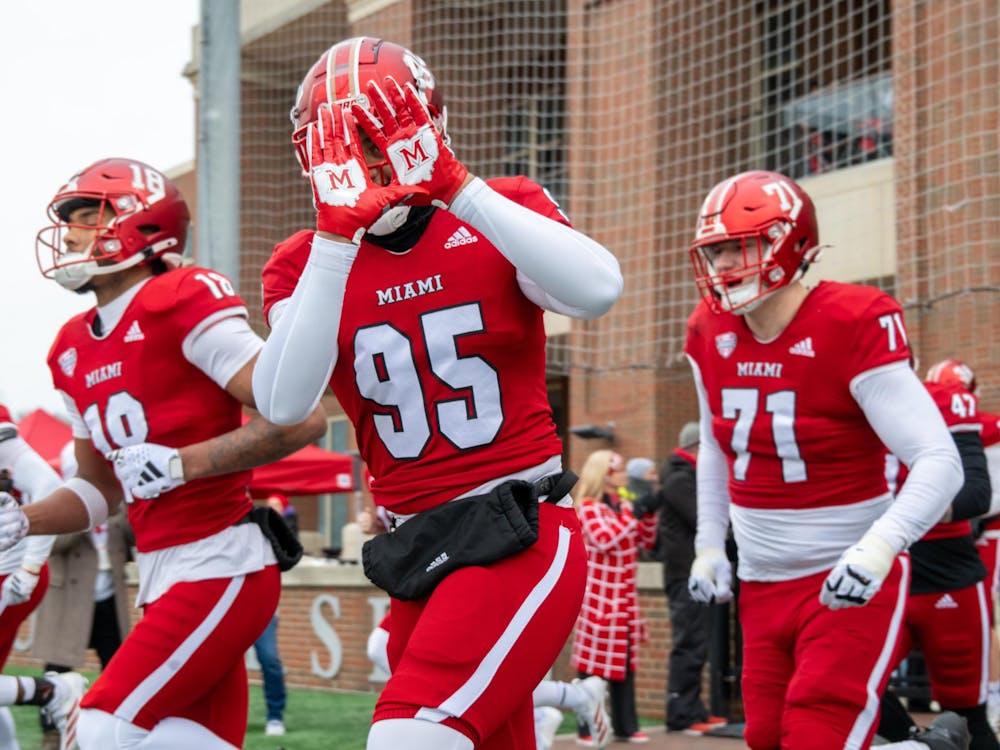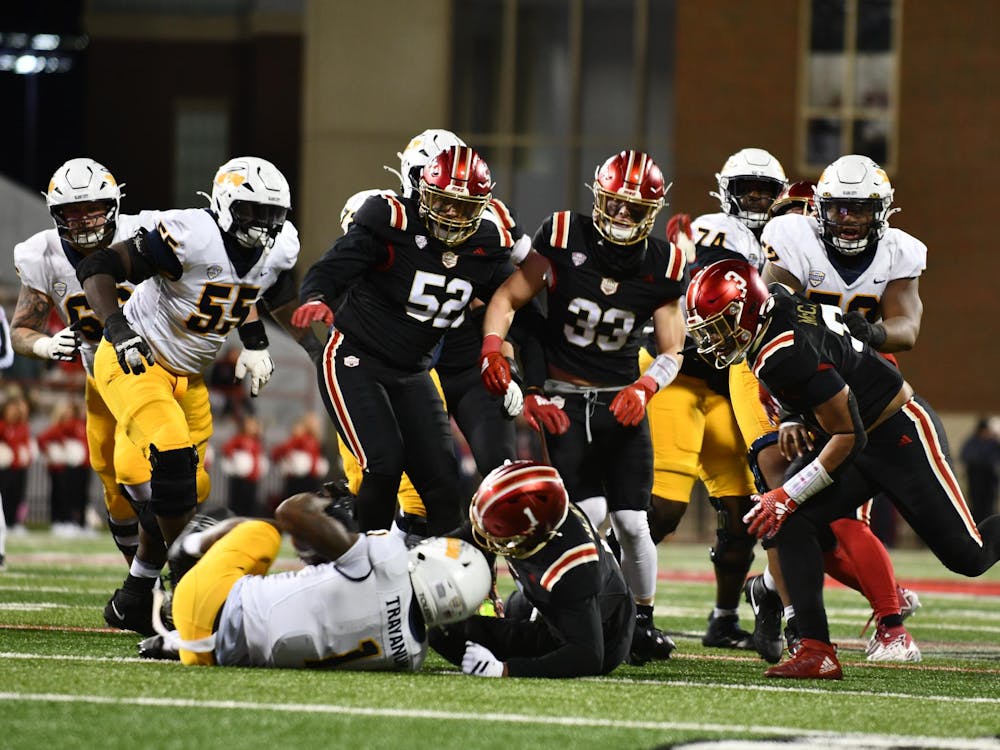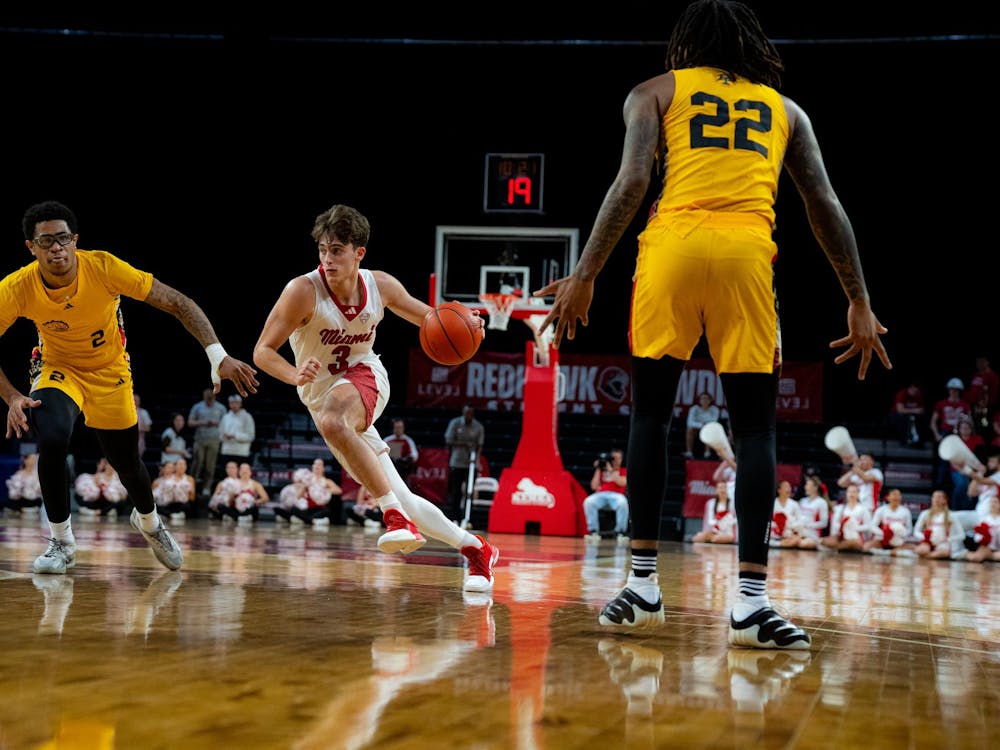The growth of analytics in sports has been flourishing since its beginnings in the early ’60s when Earnshaw Cook published Percentage Baseball, a statistical studies book that garnered national attention. Since then, the amount of data available to sport teams has grown exponentially.
In 2021, it was estimated that, in the National Hockey League (NHL), tracked players and pucks generated 2200 data points per second. At the college-level, not as many statistics are available as puck tracking has yet to be implemented, and most stats are gathered in-house.
The analytics used with Miami University’s men’s hockey team aren’t as simple as their chance of winning a matchup, but rather actionable statistics that coaches can use to tweak systems and improve performance.
“The one major live analytic that’s very consistent is face-offs,” assistant coach Zack Cizek said.
To generate this stat, a staff member is tasked with tracking the grid of the arena and marking which circles players are facing off in and against who. When a face-off occurs, coaches can use this information, relayed from the press box, to put their best player forward depending on their earlier performances in the game.
In the press box, about five people work to gather statistics, and communication is the top priority. Box scores are distributed to coaches on both teams during intermissions, and a full game report is distributed post-game. Personnel are assigned to keep track of statistics such as plus-minus, assists or blocks and relay to the caller who lets the person inputting this data into the computer system know what to input. The tempo of hockey mirrors its data collection process.
Veronica Edmonds is a senior Sports Leadership and Management (SLAM) major and women’s hockey president. She has been working with the men’s hockey team, gathering statistics since her sophomore year.
“Since hockey is so fast-paced, there’s a lot of making sure you get the information you need down quickly and then you're back and focused and ready for the next thing to happen,” Edmonds said.
Shots on goal are plotted by a staff member based on location and then graded on a letter scale from A-D, to determine if the shot was a legitimate chance or not. The further out shots are taken, the more likely they will receive a lower grade. In the press box, staff discuss controversial shot attempts and determine if they were shots or simply a dump’n’chase, a tactic that uses aggressive pressure to advance into the opponent's zone.
In-game, the coaching staff communicate with the director of hockey operations sitting in the press box. The director is cutting game tape live, tagging breakouts and scoring chances, allowing coaches to review specific game events during the contest at hand. Although many stats are player-specific, coaches can use them in a wider view and see how it affects the team.
“How many of these five guys are in the minus and if that's all tied together, then maybe that's not a good line, and you put a different line out,” Edmonds said. “Assists can go back to, ‘Yeah, this guy has a lot of assists. But who is he out there with? Should we put them out more or should we put them out with this new pair?’”
Off the ice, performance coach Keith Parker tracks various biometrics. Parker employs monthly jump tests to keep track of athlete progress and fatigue. This season, Parker is implementing a readiness assessment to subjectively monitor athletes’ sleep, mental health and nutrition by giving them a survey each day. Looking forward, Parker hopes to implement laser timers to test sprints on the ice and bring velocity-based training into the weightroom.
Enjoy what you're reading?
Signup for our newsletter
Past the stats gathered in-game, the coaching staff diligently watches back game and practice film. The coaching staff divides the season into six segments of about six games each and analyzes how players are doing individually and how the system is working during these segments to find places for improvement.
“The longer the season goes, the more we're able to stack together,” Cisek said. “The key to that is — as it can be information overload — is streamlining what's important, specifically for our team, and if we’re going to want to change something, how quickly can we change it and get everyone on the same page?”
After games, Cisek says coaches review the game individually and discuss their thoughts the next morning. In the weeks leading up to games, coaches review opponent film of their last four games. When suggestions are made, Cisek says a coach must present a great amount of evidence through film to convince the rest of the staff on board their idea.
“We all have individual ideas of what we think went well and what we think we need to adjust or work on for the next game, and one way or the other, you better have evidence of it in terms of video,” Cisek said.
As the season progresses, Miami can be more strategic about its decisions against certain opponents as their arsenal of data grows.
“In conference play, you get to see each usually four times a year,” Cisek said. “So we’re building lots of data. And then when you have data from previous years, as long as the coaching staff and style has stayed relatively the same, you're going to start to pick up on some stuff”
A major problem with the growth of analytics in the hockey field is the belief of putting gut instinct over numbers. Some players in the NHL have pushed back against the use of analytics in coaching, as Mark Scheifele of the Winnipeg Jets did when he called analytics “hogwash” in a 2021 press conference.
That season, Scheifele had outperformed what his Corsi For and Expected Goals would suggest. A Corsi analysis is a statistical technique that involves tracking shot attempts generated by a team while a particular player is on the ice, serving as a measure of their overall contribution to the team’s offensive and defensive play. However, analytical departments in the NHL have been rapidly growing as acceptance of the value of analytics increases.
“We try to blend as much as we can know about the stats that we have post-game and what we feel with the film,” Cisek said. “... I think it would probably be bad business to make any decision just based on numbers or just based on human nature. But human judgment is a big part of this. Absolutely.”




